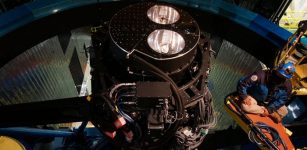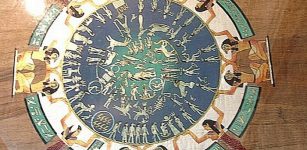Comets And Asteroids Likely Enhanced Life-Supporting Habitat On Red Planet
MessageToEagle.com – The bombardment of Mars some 4 billion years ago by comets and asteroids likely enhanced climate conditions enough to make the planet more conducive to life, at least for a time, according to a new study by researchers from the University of Colorado Boulder.
If early Mars was as barren and cold as it is today, massive asteroid and comet impacts would have produced enough heat to melt subsurface ice, said CU-Boulder Professor Stephen Mojzsis.

The impacts would have produced regional hydrothermal systems on Mars similar to those in Yellowstone National Park, which today harbor chemically powered microbes, some of which can survive boiling in hot springs or inhabiting water acidic enough to dissolve nails.
In addition to producing hydrothermal regions in portions of Mars’ fractured and melted crust, a massive impact could have temporarily increased the planet’s atmospheric pressure, periodically heating Mars up enough to “re-start” a dormant water cycle, Mojzsis explained, in a press release.
Much of the action on Mars occurred during a period known as the Late Heavy Bombardment about 3.9 billion years ago when the developing solar system was a shooting gallery of comets, asteroids, moons and planets.

Unlike Earth, which has been “resurfaced” time and again by erosion and plate tectonics, heavy cratering is still evident on Mercury, Earth’s moon and Mars, Mojzsis said.
Researchers used the Janus supercomputer cluster at the University of Colorado Computing facility for some of the 3-D modeling necessary for their study.
They looked at temperatures beneath millions of individual craters in their computer simulations to assess heating and cooling, as well as the effects of impacts on Mars from different angles and velocities.
A single model comprising the whole surface of Mars took up to two weeks to run on the supercomputer cluster, said Mojzsis.
The research is published in Earth and Planetary Science Letters.
MessageToEagle.com
Expand for referencesReferences:
Related Posts
-
 We Live In A Magnetic Universe – Galaxy Five Billion Light-Years Away Reveals
No Comments | Aug 29, 2017
We Live In A Magnetic Universe – Galaxy Five Billion Light-Years Away Reveals
No Comments | Aug 29, 2017 -
 Neutron-Star Merger Puzzle: Afterglow Continues To Brighten
No Comments | Jan 21, 2018
Neutron-Star Merger Puzzle: Afterglow Continues To Brighten
No Comments | Jan 21, 2018 -
![Scientific visualization of a numerical relativity simulation that describes the collision of two black holes consistent with the binary black hole merger GW170814. The simulation was done on the Theta supercomputer using the open source, numerical relativity, community software Einstein Toolkit (https://einsteintoolkit.org/). Credit: Argonne Leadership Computing Facility, Visualization and Data Analytics Group [Janet Knowles, Joseph Insley, Victor Mateevitsi, Silvio Rizzi].)](https://www.messagetoeagle.com/wp-content/uploads/2021/07/artifintelgrvitwaves01-307x150.jpg) Artificial Intelligence Helps To Detect Gravitational Waves
No Comments | Jul 10, 2021
Artificial Intelligence Helps To Detect Gravitational Waves
No Comments | Jul 10, 2021 -
 2400 New Eyes On The Sky To See Cosmic Rainbows
No Comments | Nov 14, 2022
2400 New Eyes On The Sky To See Cosmic Rainbows
No Comments | Nov 14, 2022 -
 Star Dancing Around Supermassive Black Hole, Proves Einstein Right
No Comments | Apr 17, 2020
Star Dancing Around Supermassive Black Hole, Proves Einstein Right
No Comments | Apr 17, 2020 -
 Chinese Rover Analyzes Moon Rocks: First New ‘Ground Truth’ In 40 Years
No Comments | Dec 23, 2015
Chinese Rover Analyzes Moon Rocks: First New ‘Ground Truth’ In 40 Years
No Comments | Dec 23, 2015 -
 Ancient Papyrus Reveals Millennia Old Astronomical Secret: The ‘Demon Star’ Algol Does Exist
No Comments | Aug 23, 2015
Ancient Papyrus Reveals Millennia Old Astronomical Secret: The ‘Demon Star’ Algol Does Exist
No Comments | Aug 23, 2015 -
 Unusual Photo Of Small Galaxy IC 1613 As Seen By ESO’s VLT Survey Telescope In Chile
No Comments | Jan 28, 2016
Unusual Photo Of Small Galaxy IC 1613 As Seen By ESO’s VLT Survey Telescope In Chile
No Comments | Jan 28, 2016 -
 Star-Making And Pollution Of Cosmos
No Comments | Aug 31, 2021
Star-Making And Pollution Of Cosmos
No Comments | Aug 31, 2021 -
 Water On Asteroid Bennu – Discovered
No Comments | Dec 11, 2018
Water On Asteroid Bennu – Discovered
No Comments | Dec 11, 2018
